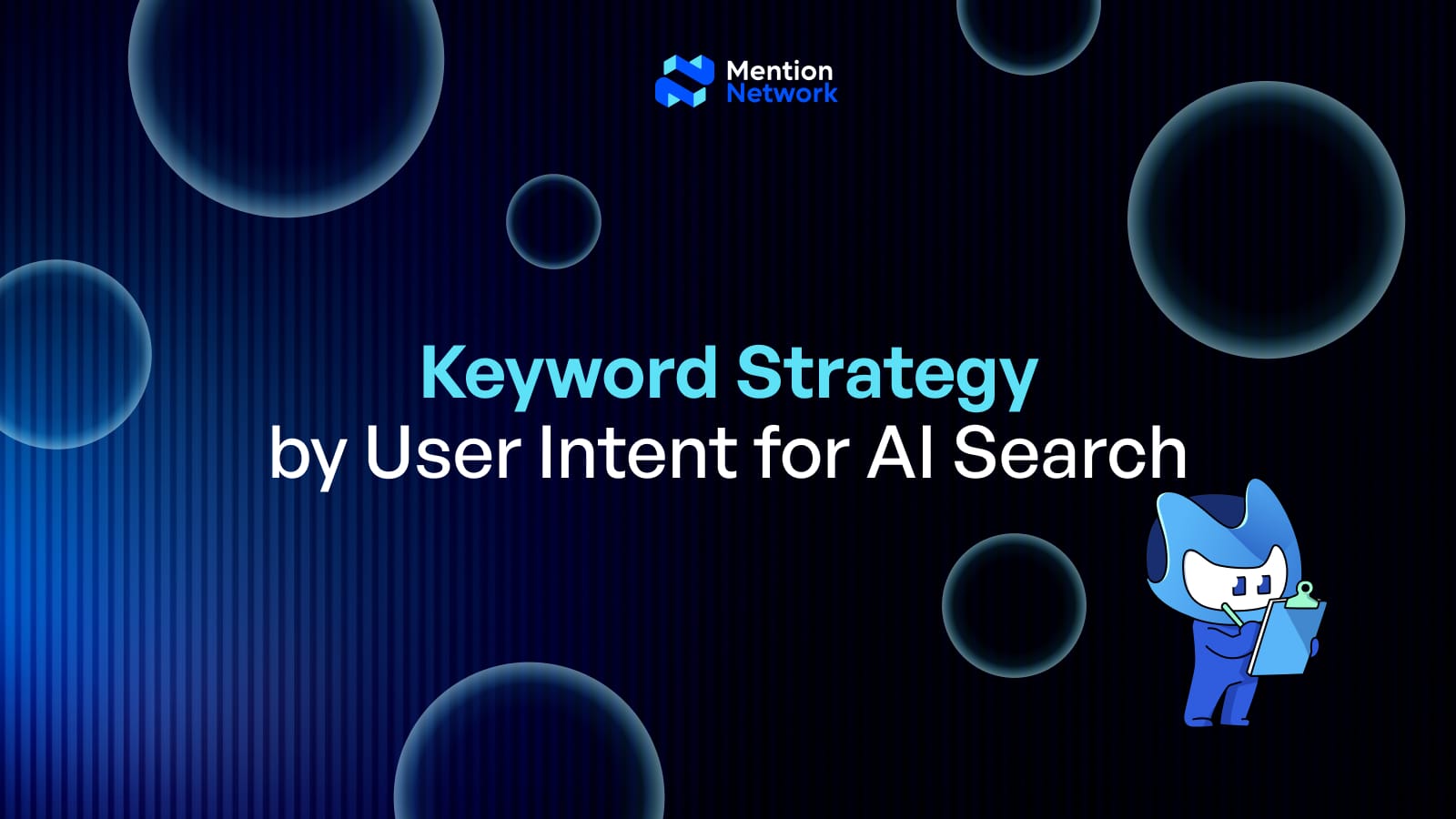Keyword Strategy by User Intent for AI Search

The rise of Generative AI has fractured the traditional keyword landscape. Where marketers once optimized for simple search terms, we must now cater to complex, conversational user prompts that reflect specific needs and phases of a decision-making journey. This demands a critical pivot: a keyword strategy driven entirely by deeply understood user intent, not just volume. For content to be cited by Large Language Models (LLMs) in AI Overviews (AIOs) and chat responses, it must precisely match the context and goal of the user’s query. We are moving from single-word targeting to entity-rich, intent-specific narrative construction.
- Intent Is the New Keyword: Generic terms yield generic results, focus on the four core user intents (Informational, Navigational, Transactional, Commercial Investigation) to structure content for citation.
- The Prompt Matrix: Map conversational queries (prompts) to specific intent types to ensure the content answers the user's implicit next step.
- Semantic Depth Wins: LLMs favor content that covers a topic exhaustively, demonstrating semantic depth over mere keyword repetition.
- Structured Data for Intent: Use Schema Markup (e.g., HowTo for instructional intent, Product for transactional intent) to signal the content's purpose directly to the AI.
- Answer-First for High Intent: High-intent queries (Transactional and Commercial) require an immediate, concise Answer-First structure to facilitate quick decision-making and citation.
- Long-Tail Authority: Focus on capturing high-complexity, long-tail queries that signal advanced user knowledge and a need for expert-level, quotable content.
1. Mapping Core User Intent to the AI Search Funnel

Effective keyword strategy in the age of AI search begins by accurately categorizing user queries into four fundamental intent types, as LLMs use intent to refine source selection and answer generation.
In traditional SEO, intent helped categorize content. In Generative Engine Optimization (GEO), intent dictates the structure and tone the LLM will favor. A prompt driven by Informational intent (e.g., "What is generative AI?") requires a definition-first, encyclopedic response. A Transactional prompt (e.g., "Buy the best CRM for startups") requires a fast, trusted recommendation and a clear call-to-action path. Misaligning the content structure with the user's intent is a primary reason for low AI visibility.
How it Works: The Citation Bias
LLMs are trained to understand the action implied by a query. If a query is commercial, the AI will prioritize content with strong E-E-A-T signals, recent data, and comparison tables. If a query is navigational, the AI will prioritize content that clearly identifies the brand and links directly to the specific resource.
2. Optimizing Informational Intent for Semantic Depth

Informational prompts, while lower in immediate conversion value, are critical for establishing the topical authority that LLMs require to cite your content for high-value queries later.
Informational content addresses the "What is" and "How does" questions. Your keyword strategy here should focus not just on the primary keyword, but on the entire semantic cluster surrounding it. If your content only defines the term without explaining its related concepts, the LLM will deem your coverage insufficient.
Why it matters: The Knowledge Graph
LLMs draw heavily on knowledge graphs and semantic networks. To win informational citations, your content must demonstrate a complete understanding of the topic's entities, relationships, and dependencies.
- Action: Ensure every key term is defined immediately (Answer-First), and include H3s that cover related concepts, technical components, and historical context. This builds semantic depth.
- Example: For the prompt, "What are the core components of Generative AI?", your content must not only define Generative AI but also introduce and define related entities like "LLMs," "Transformers," "GANs," and "Prompt Engineering."
Common Mistakes: Keyword Stuffing (Informational)
Many writers mistakenly try to increase the keyword density of the main term. The LLM does not need repetition, it needs clarity and coverage of related semantic keywords. Repetitive phrasing is often flagged as low-quality, diminishing your AI search rankings.
3. Structuring Commercial Intent Queries for Trust and Comparison
For commercial investigation prompts (e.g., "Best X for Y"), your keyword strategy must prioritize recent data, transparency, and a structured format that facilitates side-by-side comparison for the LLM.
Commercial intent queries are the most valuable because they signal a user close to a purchasing decision. LLMs treat these queries with extreme caution, demanding high E-E-A-T and fresh, unbiased content.
How it Works: The Synthesis Requirement
The AI's goal for a commercial query is to synthesize a comparison. Your content must provide the raw material for this comparison in an easily extractable format.
- Action: Use tables to compare features, pricing, and specific use-cases. Label columns clearly with entities (e.g., "Integration Capabilities," "Annual Cost," "Target Market"). Tables are highly digestible for LLMs.
- Schema for Commercial: Utilize Review and AggregateRating Schema to explicitly mark product evaluations, increasing the content's trustworthiness for commercial citation.
Example: Winning the Comparison Prompt
For a prompt like, "Compare the top three project management tools for remote engineering teams," your content should:
- List the three tools immediately.
- Dedicate H3s to each tool.
- Include a table comparing 5–7 key features (e.g., API Access, Cost per User, Reporting Detail).
- Provide a clear, expert recommendation (E-E-A-T signal).
This structured approach makes the content 10x more quotable than a long review essay.
4. Designing Transactional and Navigational Content for Direct Action
Transactional and navigational queries require a keyword strategy focused on immediacy, clear calls-to-action (CTAs), and technical precision (Schema) to drive quick conversion or resource location.
These intents are about completion: buying a product, downloading a guide, or finding a specific page. The content must be razor-focused on the outcome. The LLM needs to know the single best next step to present to the user.
Why it Matters: Conversion Path Clarity
In the AI search realm, transactional clicks are often highly qualified. The user has likely done their research and is ready to act. If your content is cited, the link must lead directly to the conversion point.
- Transactional Focus: Use Product or Offer Schema to detail the item, price, and availability. The content should be a concise summary followed by the CTA.
- Navigational Focus: Ensure the title and meta description include the exact brand and resource name. Use Organization and internal linking to confirm that your site is the official home for the resource being sought.
Common Mistakes: Distracting Fluff (Transactional)
Adding lengthy, unnecessary background information to a transactional page (e.g., a long intro on the product page before the "Buy Now" button) is a critical error. The AI search user expects efficiency, any delay in providing the link or instruction reduces conversion likelihood.
5. From Keywords to Prompts: Building the Long-Tail Authority

The most sustainable keyword strategy for AI search is to abandon the pursuit of high-volume, vague keywords and instead focus entirely on capturing long-tail, high-complexity prompts that demonstrate expert authority.
Vague, high-volume keywords (e.g., "SEO") are difficult to rank for and rarely lead to a specific citation because the topic is too broad. High-complexity prompts (e.g., "How does Google's new LLM architecture prioritize E-E-A-T signals for financial services blogs?") are lower in volume but are answered by highly specialized content that the LLM is eager to cite.
How it Works: The Authority Feedback Loop
- Capture Prompt: You create the definitive answer to a complex, long-tail prompt.
- LLM Cites: The LLM cites your content for its authority and semantic depth.
- Authority Grows: This citation increases your E-E-A-T score across the broader topic cluster.
- Rank for Head Terms: Over time, your established authority helps you rank for shorter, higher-volume terms as well.
This is the ultimate GEO feedback loop: Authority earned through complex, intent-driven content translates into higher visibility across all AI search rankings.
6. Integrating Schema and Prompt Entities for Maximum Citation
The final layer of a robust keyword strategy is ensuring that the key entities mentioned in the user's prompt are explicitly marked using Schema within your content.
LLMs are highly entity-aware. If a user asks about "the best CRM by HubSpot," the entities are "CRM" and "HubSpot." Your content must not only mention these terms but ideally mark them with SoftwareApplication and Organization Schema, respectively. This removes ambiguity and gives the LLM high confidence in your facts.
Example: Entity-Specific Schema
If your article discusses the "Transformer architecture," the phrase should ideally be marked using Article or AboutPage Schema that defines it as a key technical entity within the broader topic of AI. This is a level of precision that transcends traditional keyword usage and is fundamental to winning the AI search game. The goal is to make the relationship between the prompt and your facts machine-readable.
Conclusion: The Intent-First Mandate
The future of organic visibility belongs to the strategist who masters the keyword strategy of user intent. The era of targeting keywords for volume is over, the era of architecting content for citation based on precise, conversational prompts has begun. By systematically structuring your content around the four core intents Informational, Navigational, Commercial, and Transactional and reinforcing that structure with semantic depth and clear Schema, you move from passively hoping for a rank to actively engineering the generative outcome. The intent-first mandate ensures your content is not just found, but trusted, quoted, and relied upon by the AI systems that mediate the modern web.
FAQ: Keyword Strategy by User Intent
Why is traditional keyword density irrelevant for AI search?
LLMs use semantic depth and contextual understanding, not keyword density. Over-repetition of a keyword is unnecessary and can signal low-quality content, reducing citation chances.
How do I find the "conversational prompts" I should target?
Analyze "People Also Ask" sections, social media forums (Reddit/Quora), and customer service tickets. These sources reveal the actual, long-tail questions users are asking rather than simple keywords.
Does informational content still matter if it doesn't convert immediately?
Yes. Informational content builds your site's foundational topical authority and E-E-A-T, which is essential for the LLM to trust you when answering high-intent, commercial queries later on.
What is the highest priority Schema for intent-driven content?
FAQPage for Informational intent, HowTo for Transactional intent, and Review/AggregateRating for Commercial intent are the highest-impact types for influencing AI citation.

